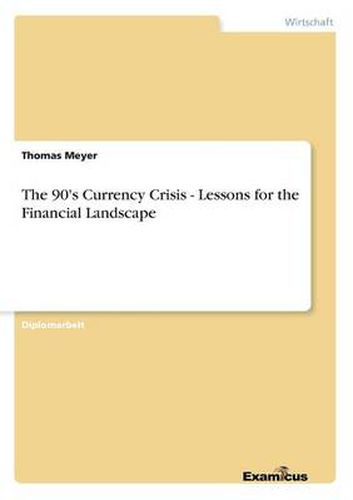Readings Newsletter
Become a Readings Member to make your shopping experience even easier.
Sign in or sign up for free!
You’re not far away from qualifying for FREE standard shipping within Australia
You’ve qualified for FREE standard shipping within Australia
The cart is loading…






This title is printed to order. This book may have been self-published. If so, we cannot guarantee the quality of the content. In the main most books will have gone through the editing process however some may not. We therefore suggest that you be aware of this before ordering this book. If in doubt check either the author or publisher’s details as we are unable to accept any returns unless they are faulty. Please contact us if you have any questions.
Diplomarbeit aus dem Jahr 2000 im Fachbereich VWL - Finanzwissenschaft, Note: 1, Freie Universitat Berlin, Sprache: Deutsch, Abstract: When on June 2nd 1997 Thailand devalued its currency, the stage was set was the most severe and virulent currency crisis of that decade. The sudden reversal of capital flows depleted economic wealth and social cohesion in many East Asian countries, hitherto perveived to belong to the Asian Miracle. Shockwaves of the crisis were felt in most emerging markets, even those outside the region, and reached mature markets when, for instance, the hedge fund Long-Term Capital Management nearly collapsed. In face of these enormous costs, this paper analyses the possibilities and boundaries of attempts to either reduce the likeliness of respective financial shocks or, when unavoidable, lower the costs of managing these crises. On the ground of the state-of-the-art models of currency crises it is examined which domestic or international factors contributed most to the observed outcome. The guiding question is if either moral hazard considerations, in the form of governmental guarantees and alike, or approaches of multiple equilibria are more suited to serve as an explanation. Moreover, this paper illuminates the significance of the original sin hypothesis which states that emerging markets are constrained when trying to borrow abroad in domestic currency or, even when trying at home, to borrow long-term. Although it is acknowledged that all these factors are valid simultaniously, superior importance in the following parts is given on the multiple equilibria approach.
$9.00 standard shipping within Australia
FREE standard shipping within Australia for orders over $100.00
Express & International shipping calculated at checkout
This title is printed to order. This book may have been self-published. If so, we cannot guarantee the quality of the content. In the main most books will have gone through the editing process however some may not. We therefore suggest that you be aware of this before ordering this book. If in doubt check either the author or publisher’s details as we are unable to accept any returns unless they are faulty. Please contact us if you have any questions.
Diplomarbeit aus dem Jahr 2000 im Fachbereich VWL - Finanzwissenschaft, Note: 1, Freie Universitat Berlin, Sprache: Deutsch, Abstract: When on June 2nd 1997 Thailand devalued its currency, the stage was set was the most severe and virulent currency crisis of that decade. The sudden reversal of capital flows depleted economic wealth and social cohesion in many East Asian countries, hitherto perveived to belong to the Asian Miracle. Shockwaves of the crisis were felt in most emerging markets, even those outside the region, and reached mature markets when, for instance, the hedge fund Long-Term Capital Management nearly collapsed. In face of these enormous costs, this paper analyses the possibilities and boundaries of attempts to either reduce the likeliness of respective financial shocks or, when unavoidable, lower the costs of managing these crises. On the ground of the state-of-the-art models of currency crises it is examined which domestic or international factors contributed most to the observed outcome. The guiding question is if either moral hazard considerations, in the form of governmental guarantees and alike, or approaches of multiple equilibria are more suited to serve as an explanation. Moreover, this paper illuminates the significance of the original sin hypothesis which states that emerging markets are constrained when trying to borrow abroad in domestic currency or, even when trying at home, to borrow long-term. Although it is acknowledged that all these factors are valid simultaniously, superior importance in the following parts is given on the multiple equilibria approach.